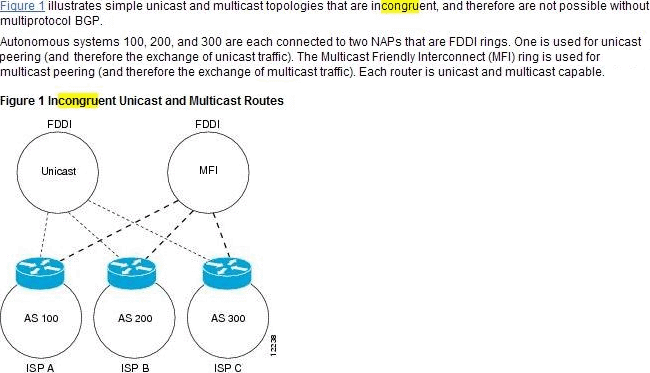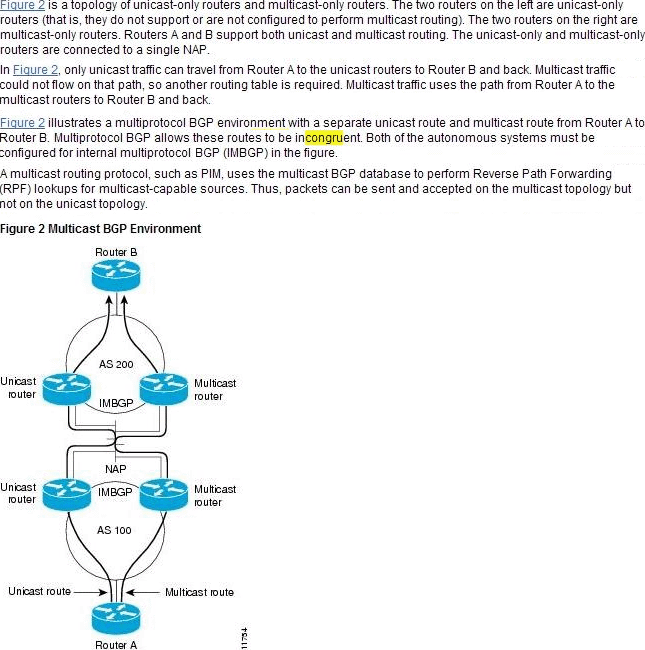When enabling interdomain multicast routing, which two statements are correct? (Choose two.)
When enabling interdomain multicast routing, which two statements are correct? (Choose two.)
A . Multiprotocol BGP is used instead of PIM SM to build the intradomain and interdomain multicast distribution trees
B . Use MSDP to enable the RPs from different domains to exchange information about active multicast sources
C . MSDP SA packets are sent between the multiprotocol BGP peers
D . Noncongruent unicast and multicast topologies can be supported using multiprotocol BGP
Answer: B,D
Explanation:
http://prakashkalsaria.wordpress.com/2010/08/11/mbgp-msdp/
MSDP In the PIM-SM model, multicast sources and receivers must register with their local RP. Actually, the routerclosest to the sources or receivers registers with the RP, but the key point to note is that the RP knows aboutall the sources and receivers for any particular group. RPs in other domains have no way of knowing aboutsources located in other domains. MSDP is an elegant way to solve this problem.
MSDP is a mechanism that allows RPs to share information about active sources. RPs know about thereceivers in their local domain. When RPs in remote domains hear about the active sources, they can pass onthat information to their local receivers and multicast data can then be forwarded between the domains. Auseful feature of MSDP is that it allows each domain to maintain an independent RP that does not rely on otherdomains, but it does enable RPs to forward traffic between domains. PIM-SM is used to forward the trafficbetween the multicast domains.
The RP in each domain establishes an MSDP peering session using a TCP connection with the RPs in otherdomains or with border routers leading to the other domains. When the RP learns about a new multicastsource within its own domain (through the normal PIM register mechanism),
the RP encapsulates the first datapacket in a Source-Active (SA) message and sends the SA to all
MSDP peers. The SA is forwarded by eachreceiving peer using a modified RPF check, until the SA reaches every MSDP router in the interconnectednetworks―theoretically the entire multicast internet. If the receiving MSDP peer is an RP, and the RP has a (*,G) entry for the group in the SA (there is an interested receiver), the RP creates (S, G) state for the source andjoins to the shortest path tree for the source. The encapsulated data is decapsulated and forwarded down theshared tree of that RP. When the packet is received by the last hop router of the receiver, the last hop routeralso may join the shortest path tree to the source. The MSDP speaker periodically sends SAs that include allsources within the own domain of the RP
http://www.cisco.com/en/US/docs/ios_xr_sw/iosxr_r3.2/routing/configuration/guide/rc32bgp.html
Multiprotocol BGP
Multiprotocol BGP is an enhanced BGP that carries routing information for multiple network layer protocols andIP multicast routes. BGP carries two sets of routes, one set for unicast routing and one set for multicast routing.
The routes associated with multicast routing are used by the Protocol Independent Multicast (PIM)
feature tobuild data distribution trees.
Multiprotocol BGP is useful when you want a link dedicated to multicast traffic, perhaps to limit which resourcesare used for which traffic. Multiprotocol BGP allows you to have a unicast routing topology different from amulticast routing topology providing more control over your network and resources.
In BGP, the only way to perform interdomain multicast routing was to use the BGP infrastructure that was inplace for unicast routing. Perhaps you want all multicast traffic exchanged at one network access point (NAP).
If those routers were not multicast capable, or there were differing policies for which you wanted multicasttraffic to flow, multicast routing could not be supported without multiprotocol BGP.
Note It is possible to configure BGP peers that exchange both unicast and multicast network layer reachabilityinformation (NLRI), but you cannot connect multiprotocol BGP clouds with a BGP
cloud. That is, you cannotredistribute multiprotocol BGP routes into BGP.



